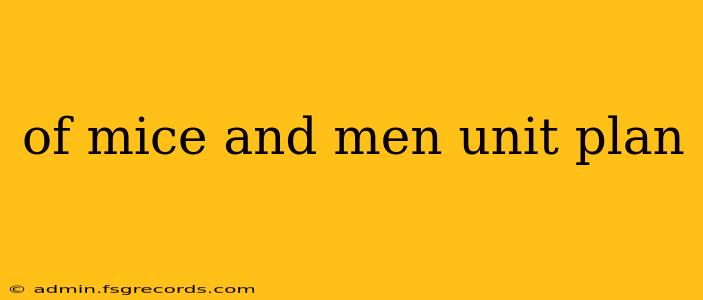This unit plan provides a detailed framework for teaching John Steinbeck's Of Mice and Men, focusing on deep engagement with the text and its thematic complexities. It's designed to be adaptable to various grade levels (typically 9-12) and learning styles, incorporating a variety of activities to foster critical thinking and creative expression.
Unit Overview
Time Allotment: 3-4 weeks (adjustable based on class schedule and student needs)
Overall Goals: Students will be able to:
- Analyze the novel's major themes (e.g., loneliness, the American Dream, friendship, prejudice, power, fate).
- Understand the historical and social context of the novel (the Great Depression and migrant worker experience).
- Interpret Steinbeck's use of literary devices (symbolism, foreshadowing, imagery, characterization).
- Develop critical thinking skills through discussions, essays, and presentations.
- Connect the themes of Of Mice and Men to contemporary issues and personal experiences.
Weekly Breakdown
Week 1: Introduction and Setting the Stage
- Day 1-2: Introduction to John Steinbeck and the historical context of the Great Depression. Discussion of migrant worker life and the societal challenges of the era. Preliminary reading of Chapter 1.
- Day 3-4: Close reading of Chapters 1 and 2. Focus on character introduction, setting description, and foreshadowing. Class discussions focusing on the initial development of George and Lennie's relationship and the introduction of key themes. Activities: Character sketches, prediction activities.
Week 2: Developing Themes and Character Analysis
- Day 5-6: Reading and discussion of Chapters 3 and 4. Analysis of Candy, Crooks, and Curley's Wife's roles and their individual struggles. Exploration of themes of loneliness, prejudice, and the elusive American Dream. Activities: Character analysis essays (focused on one character), Socratic seminar discussions.
- Day 7-8: Deeper dive into the symbolism within the novel. Focus on specific symbols (e.g., Lennie's puppy, the rabbits, the ranch setting itself). Exploration of how these symbols contribute to the novel's overall meaning. Activities: Symbolism identification and interpretation exercises, creative writing prompts based on chosen symbols.
Week 3: Climax, Resolution, and Themes
- Day 9-10: Reading and discussion of Chapters 5 and 6. Analysis of the climax and resolution of the story. Class discussions focusing on the impact of Lennie's actions and the ultimate tragedy of the story. Examination of the theme of fate versus free will. Activities: Debate on George's actions, character diary entries.
- Day 11-12: Review and consolidation of major themes. Preparation for culminating assessment. Activities: Review games, thematic essay brainstorming sessions.
Week 4: Culminating Assessment and Extension Activities
- Day 13-14: Culminating assessment (e.g., essay, presentation, creative project). This could focus on a specific theme, character analysis, or a comparison to a modern-day equivalent.
- Day 15-16: Extension activities: Film adaptation comparison, research into the historical context of the novel, creative writing projects (e.g., alternative endings, sequel stories).
Assessment Strategies
- Formative Assessments: Class discussions, participation, in-class writing assignments, quizzes on vocabulary and comprehension.
- Summative Assessments: Essay on a chosen theme, character analysis, creative project (e.g., dramatic scene, short film, artwork), presentation.
Differentiation Strategies
- For struggling learners: Provide graphic organizers, simplified reading materials, and opportunities for peer support.
- For advanced learners: Encourage independent research, extended writing assignments, and opportunities for leadership in group projects.
This unit plan provides a comprehensive framework. Remember to adapt and adjust based on your students' specific needs and learning styles. Engaging with the text actively, fostering thoughtful discussion, and encouraging creative expression will lead to a richer and more meaningful learning experience for your students.

